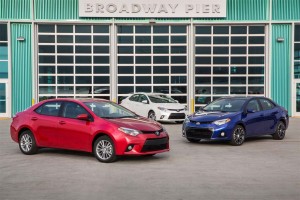Toyota plans to begin shipping U.S.-made Corolla sedans to 18 countries in Latin America and the Caribbean starting next year.
The move is part of a rapid ramp-up of exports from the U.S. by the world’s largest automaker which already ships vehicles from the States to markets as diverse as Europe and Asia. And Toyota isn’t alone, a growing number of its competitors also using the U.S. as an export base to take advantage of the weak dollar – and their expanding North American production networks.
“Toyota’s U.S. manufacturing operations continue to grow as a key supplier of cars and trucks for global markets, which is only possible thanks to the dedication and high-quality work of our team members here,” said Jim Lentz, CEO of Toyota’s North America Region, “the export of U.S.-built Corolla sedans to Latin America and the Caribbean will help to further solidify our U.S. manufacturing base.”
Toyota earlier this year began shipping its Venza crossover from the U.S. to Russia and the Ukraine and last year added several American-made products to its line-up in South Korea. That is likely to push its total exports to a new record in 2013 after hitting a previous high last year. In fact, 2012 saw exports rise 45% to 124,000 with U.S.-made Toyotas shipped to 21 global markets.
(Click Here to check out the review of the 2014 Toyota Corolla.)
Japan’s second-largest automaker also has growing plans for U.S.-made models. Part of Nissan’s $5 billion investment program in the Americas is earmarked for the expansion of U.S. exports. With the recent shipment of U.S,-made Pathfinders to Australia and New Zealand, Nissan currently counts 61 global export markets. It says that will jump to as many as 119 next year when the Canton, Mississippi plant becomes the global source for the Nissan Murano.
About 12% of Nissan’s U.S. capacity was earmarked for export in 2012. That is expected to approach 14% this year and continue to grow, the maker said.
(Nissan planning big boost in production in the Americas. Exports a critical reason. Click Here for more.)
Japanese makers aggressively ramped up export plans in recent years as a hedge against the strong yen which made it increasingly difficult to use the Japanese home market as a global manufacturing base. But even with the yen sharply declining in value in recent months, Nissan CEO Carlos Ghosn said the maker won’t reverse course and will continue to increase the use of the States for export production.
Part of the reason is new free trade agreements Washington has inked with, among other nations, South Korea.
Honda exported more than 100,000 vehicles to markets outside of North America last year, and every Honda auto plant in North America now builds at least some cars and trucks for export, including operations in Ohio, Alabama and Indiana. Exported models go to 40 different countries and include the Honda Civic, Accord, CR-V, Pilot, Odyssey, Crosstour and Ridgeline, along with the Acura ILX, TL, RDX and MDX.
(VW likely to use Tennessee plant as global export base for new CrossBlue crossover. Click Here for that story.)
German makers, trying to cope with the high cost of manufacturing in their own home market have increased exports from the U.S. sharply, as well. As much as half of the M- and G-Class vehicles assembled at the Mercedes-Benz plant near Birmingham, Alabama are earmarked for markets outside North America. When the next-generation Mercedes C-Class launches at the expanding facility it is expected to join the export list.
“In the future, we will have more competition between plants,” Daimler AG Board Member Thomas Weber said earlier this year, noting that even U.S.-made Mercedes engines will likely be used on assembly lines around the world.
BMW’s plant in Spartanburg, South Caroline, meanwhile, produces over 1,000 vehicles each day and is the exclusive global supplier of X3, X5 and X6 Sports-Activity Vehicles. The Spartanburg plant is expected to produce more than 300,000 vehicles this year and will export approximately 70% of those vehicles to more than 130 countries.
Ironically, Detroit manufacturers have been lagging on the export front but there are signs that are changing, all three increasing their tallies. Chrysler has been especially aggressive, in large part because of its expanding relationship with Italian partner Fiat. Sergio Marchionne, who serves as CEO for both makers, has been trying to rationalize the Fiat/Chrysler global footprint. That means a worldwide market for U.S.-made Jeeps, while products such as the Chrysler 300 sedan will be shipped to Europe and sold there under the Lancia badge.
Exports from the U.S. lag well behind those of the country’s neighbor to the South, however. Mexico is quickly becoming one of the industry’s largest export bases due to a variety of factors that include low wages as well as the wide range of free trade agreements the Mexican government has negotiated.
Audi, Volkswagen, Mazda, Honda and Mercedes are all in the process of opening new plants in Mexico, and the potential for large-scale exports played a critical role in the planning for each of those new facilities. Nissan, for one, exported 268, 219 vehicles from Mexico last year to markets outside North America – more than seven times the total it shipped from its U.S. assembly plants.


You can tell that U.S. labor rates are too low when Asian car makers export U.S. produced products to other countries.